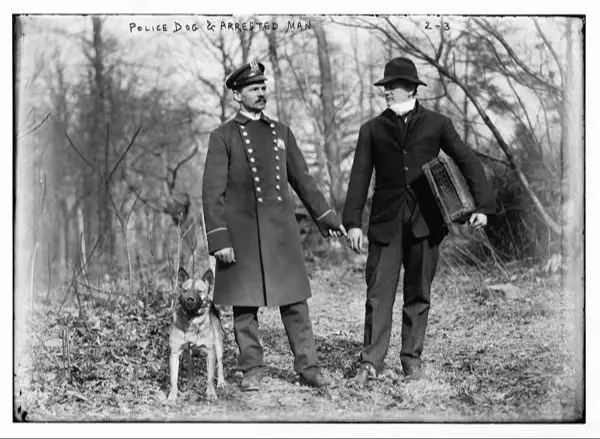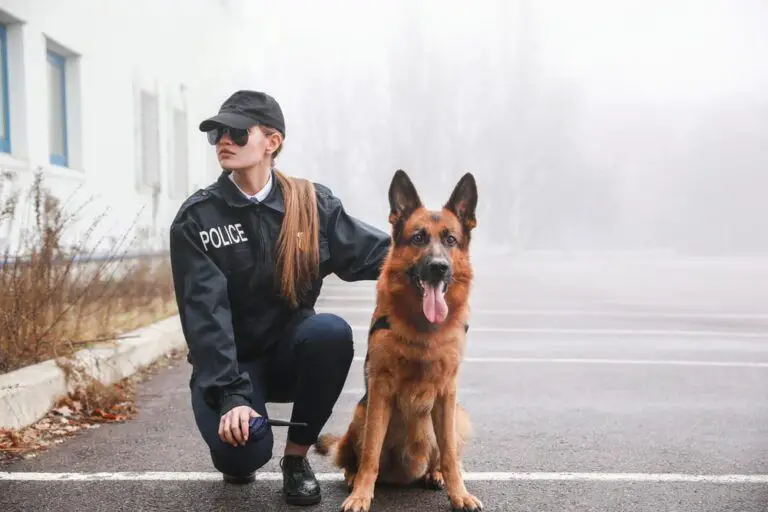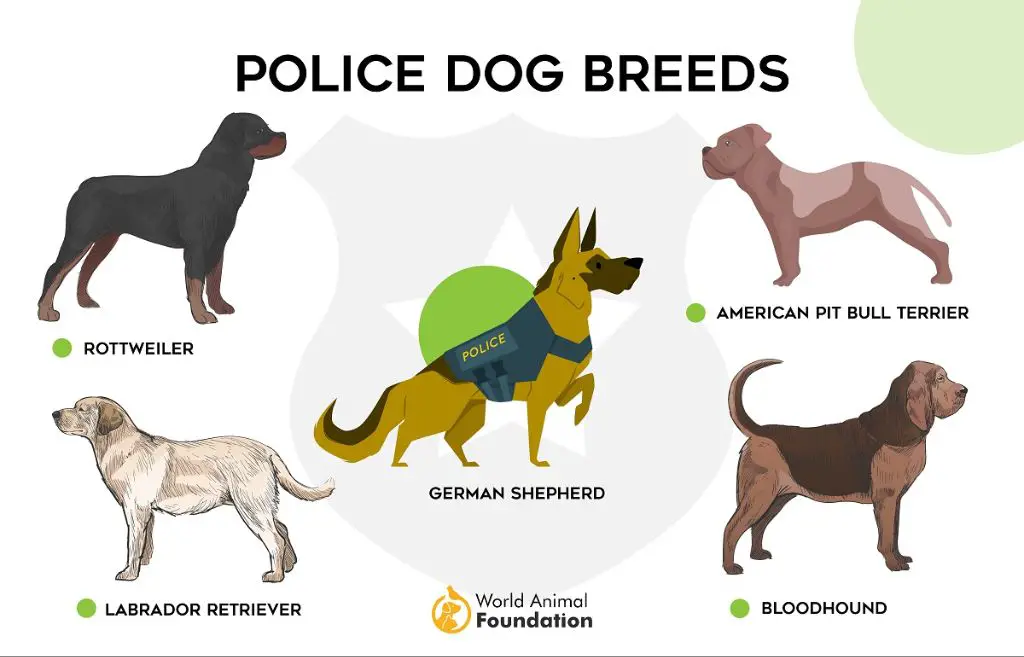Introduction
Police dogs, also known as K-9 units, have become an invaluable asset to law enforcement over the years. With their exceptional sense of smell and ability to track suspects, these highly trained canines help police apprehend criminals, detect explosives and illegal drugs, search buildings and vehicles, find missing people, and more. Police dogs are fierce when needed but also extremely loyal and obedient to their human handlers.
When people think of police dogs, German Shepherds often come to mind first. Their intelligence, athleticism, work ethic, and protective instincts make them well-suited for the demanding roles required of K-9 units. But several breeds besides German Shepherds have proven to be successful police dogs as well. This article will explore the history and duties of police dogs, the breeds most often utilized, and the extensive training these specialized canines undergo to serve and protect their communities.
History
Dogs have been used in police work for over a century. The first police dogs were used in Ghent, Belgium in the late 1800s to track criminals and search for evidence (https://customcanineunlimited.com/the-history-of-police-k9-dogs/). In New York City, the police department began an experimental program with dogs in 1907. Most early police dogs were bloodhounds, known for their incredible sense of smell and tracking abilities.

Police dogs started to be more widely used in Germany in the early 1900s. The German Shepherd was found to be an ideal breed for police work due to its intelligence, trainability, and physical abilities. Their use expanded greatly during World War I and II. The first organized police dog training program was established in Germany in 1920.
In the 1950s and 1960s, many US police departments established K-9 units, often adopting training techniques developed in Europe. Police dogs were mainly used for patrol work andcrowd control. Over time, their roles expanded to include search and rescue, detecting bombs and drugs, and locating crime evidence.
Today, police dogs are considered an indispensable part of police departments around the world. Their duties continue to evolve alongside technology and policing strategies. However, their superior senses, loyalty, and ability to be trained remain essential to their success as working dogs (http://www.german-shepherd-lore.com/k9-police-dogs.html).
Most Common Breeds
There are a few breeds that stand out as the most popular and effective breeds used in police and military work. According to sources, the top three breeds are:
German Shepherd
The German Shepherd is one of the most commonly used breeds in police work. German Shepherds make up about half of the police dog population (Tactical Police K9 Training, 2023). They have an excellent sense of smell and can be trained for drug detection, search and rescue, and apprehension. German Shepherds are known for being intelligent, loyal, and easy to train. Their athleticism and strength also make them well-suited for police duties.

Belgian Malinois
Belgian Malinois have surged in popularity in recent years. Though they used to be outnumbered by German Shepherds, some estimates now show that up to 80% of dogs purchased for police work are Belgian Malinois (Dog Academy, 2023). The Malinois is smaller and faster than the German Shepherd, with a high drive and energy level. Their intelligence and trainability make them excellent at detecting drugs and explosives as well as apprehending suspects.
Bloodhound
While not as common for apprehension or attack duties, Bloodhounds are unmatched in their scent tracking abilities. With approximately 300 million scent receptors, their sense of smell is one of the best in the dog world (Dog Academy, 2023). When it comes to finding lost people or fugitives, Bloodhounds are the breed of choice for many police departments. Their ability to detect and follow even faint or days-old scents makes them invaluable for search and rescue operations.
Senses
Police dogs rely heavily on their extraordinary senses to perform their duties. Their sense of smell, in particular, is vital for tasks like tracking, searching for drugs or explosives, and finding missing persons. A police dog’s nose has up to 300 million scent receptors, whereas humans only have around 5 million. This allows them to detect odors at concentrations up to 100 million times lower than humans can detect. Police dogs can pinpoint the location of odors and track them to their source across long distances and even days later.
Police dogs also have excellent hearing, with the ability to detect sounds at distances up to 4 times farther than humans. Their movable ears allow them to pinpoint the origin of faint sounds with precision accuracy. This aids in tasks like pursuing suspects or finding people buried beneath rubble.
In addition, police dogs have good night vision and keen eyesight for detecting movement at distances over half a mile away. Their vision complements their hearing and smell, allowing them to thoroughly survey areas and visually identify suspects or items of interest. Altogether, a police dog’s powerful senses allow them to find what human officers often cannot.
Training

Police dogs go through extensive training to prepare them for their demanding roles on the force. Training begins when the dogs are just puppies and continues throughout their careers. Experienced trainers work closely with the dogs using positive reinforcement techniques to instill discipline and teach them crucial skills.
Some of the main things police dogs learn during training include:
- Obedience – Police dogs must follow their handler’s commands precisely in chaotic situations.
- Tracking – Dogs use their powerful sense of smell to locate suspects, drugs, weapons, and missing persons.
- Patrolling – Dogs learn to walk off-leash, conduct building searches, and protect their handlers.
- Criminal apprehension – Dogs are trained to chase down and hold suspects without injuring them.
Handlers and dogs attend training schools together and form strong bonds. Trainers carefully match each dog with a handler they will work well with. The handler learns the dog’s personality and capabilities in order to direct them effectively in the field. It takes many months of daily training to produce an effective K9 team.
With dedicated work from both the handler and trainer, police dogs develop into focused, controlled working dogs. Their intensive training prepares them to carry out their duties with skill and diligence while maintaining a calm, friendly demeanor.
Duties
Police dogs are highly trained to carry out a variety of duties to assist law enforcement. Some of the most common duties include:
Tracking – Police dogs use their powerful sense of smell to track suspects or lost persons. They can follow a scent trail on the ground or in the air to locate criminals or missing persons. Dogs like Bloodhounds excel at tracking with their 300 million scent receptors.
Searching – Police dogs are used to search buildings, vehicles, bags, and large outdoor areas for suspects or dangerous items like explosives or illegal drugs. Their excellent sense of smell allows them to detect things officers would easily miss.
Apprehending suspects – When a dangerous suspect tries to escape or resist arrest, a police dog can be released to chase and hold the suspect until officers arrive. The dogs are trained to bite and hold on command.
Locating drugs/bombs – With their keen sense of smell, police dogs can sniff out illegal drugs like heroin, cocaine, methamphetamines, or marijuana. They can also detect the unique chemical smells associated with different explosive materials.
Other duties – Police dogs also provide security for officers during patrols, riots or crowd control. They help officers establish probable cause for vehicle searches. Police dogs also help calm victims or witnesses at crime scenes and events.
Success Stories
Police dogs have made a tremendous impact in the field. Here are some real examples of their heroic actions:
In 2019, K-9 Officer Nick located a missing 3-year-old boy in a dense wooded area in Kentucky within 28 minutes of searching. The boy likely would not have survived the frigid temperatures overnight without the dog’s keen sense of smell and tracking abilities (https://klaus-rederer.de/malinois-dog-rescue).
K-9 Max helped apprehend a barricaded suspect after a shootout in California in 2018. Despite taking a bullet during the incident, Max charged and subdued the armed suspect, saving the lives of officers on the scene.
During the Boston Marathon bombing investigations in 2013, K-9 leads were critical in locating evidence and tracking down the suspects. The work of the K-9 teams was praised for their lifesaving contributions.
These stories demonstrate the bravery, intelligence, and loyalty of police dogs on the job. Their unique abilities make them invaluable partners for law enforcement in keeping communities safe.
Retirement
Once police dogs reach a certain age, usually around 8-10 years old, they are retired from active duty. Their handlers and police departments then have some options for the dogs’ retirement (Source: “510 ILCS 82/ Police Dog Retirement Act”). Many handlers end up adopting their retired partners to live out the rest of their days in a home environment. This allows the handler and dog to continue their bond in a more relaxed setting.
If the handler is not able to adopt their retired dog, police departments will often offer the dog to another qualified officer or employee. This allows the dog to retire with someone familiar while freeing up the original handler to start working with a new dog. Adoption by a former handler or other officer ensures the retired dogs go to good homes with people who understand their needs (Source: “Governor Signs Bill Creating Police Dog Retirement Act”).
In retirement, police dogs can enjoy relaxing walks, plenty of playtime, and spending quality time with loving families. It’s a well-deserved change of pace after years of demanding service. Adoption and retirement programs show how much police departments value and care for their K-9 partners.
Controversies
Police dogs have faced some controversies over their use in law enforcement. Critics have raised concerns about police dogs biting suspects, false alerts leading to unwarranted searches, and dogs being shot by officers in the line of duty.
One major area of controversy is police dog bites. These powerful dogs are trained to apprehend suspects by biting and holding them. However, critics argue that police dogs sometimes attack suspects who have surrendered or are following police orders. There are numerous cases of severe injuries and even death resulting from police dog bites. Some believe the dogs are not always properly trained or controlled by handlers.
Another issue is false alerts from police dogs during searches and investigations. Dogs can mistakenly signal the presence of drugs or explosives, leading police to conduct invasive searches. Critics say this violates civil liberties and unduly escalates police encounters. They argue that dogs should not be considered probable cause for searches.1
There is also controversy around police dogs being shot by officers, often when the dog is released to subdue a suspect. This has resulted in backlash and accusations of unnecessary force being used against the dogs. Advocates argue more precautions should be taken to protect working police dogs on the job.
Overall, critics say more oversight and higher standards need to be implemented for police dog training and handling. They want restrictions put in place to prevent abuse and misuse, while ensuring public and suspect safety.
Conclusion

In summary, police dogs play a critical role in law enforcement around the world. The most commonly used breeds are German Shepherds, Belgian Malinois, Dutch Shepherds, and Boxers due to their intelligence, trainability, athleticism, sense of smell, hearing, and protective nature. Through extensive training starting from a young age, police dogs are taught to utilize their natural abilities to perform a variety of duties including tracking suspects, detecting drugs and explosives, finding missing people, and apprehending dangerous criminals. Their extraordinary senses combined with their loyal partnership with handlers makes police dogs invaluable assets in police work. They have helped solve numerous crimes and saved countless lives. While retirement can be difficult for police dogs who are used to the stimulation of active duty, most retired K9s continue to live full lives with their handlers and families after years of admirable service protecting their communities.